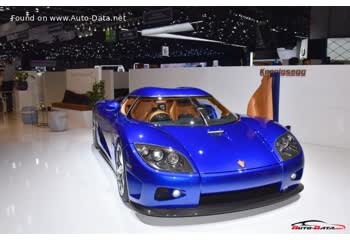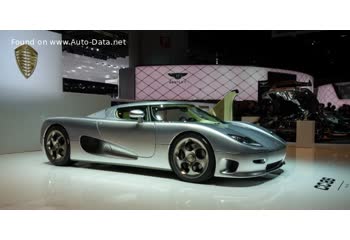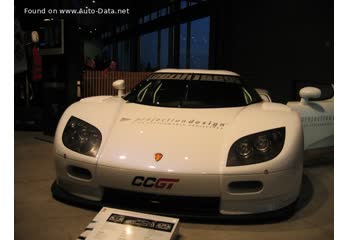Everything you need to know about specifications and performance - Koenigsegg CC 2004 - 4.7 i V8 32V (806 Hp)

Overview:
What is the engine capacity of a Koenigsegg CC 2004?
The engine capacity of the Koenigsegg CC 2004 is 4719.
Koenigsegg CC 2004 How many horsepower?
The engine power of the Koenigsegg CC 2004 is 806 Hp @ 6900 rpm..
How much gasoline does a Koenigsegg CC 2004 consume?
The Koenigsegg CC 2004 consumes 17 liters of gasoline per 100 km
General:
Brand: Koenigsegg
Model: CC
Generation: CCR
Modification (Engine): 4.7 i V8 32V (806 Hp)
Start of production: 2004
End of production: 2006
Powertrain Architecture: Internal Combustion Engine
Body type: Coupe
Seats: 2
Doors: 2
Engine:
Power: 806 hp @ 6900 rpm.
Power per litre: 170.8 hp/l
Torque: 919 nm @ 5700 rpm.
Engine displacement: 4719
Number of cylinders: 8
Engine configuration: V-engine
Number of valves per cylinder: 4
Fuel injection system: Multi-port manifold injection
Engine aspiration: Turbocharger, Intercooler
Engine layout: Middle, Longitudinal
Compression ratio: 8.6:1
Performance:
Fuel Type: Petrol (Gasoline)
Fuel consumption (economy) - urban: 25 l/100 km
Fuel consumption (economy) - extra urban: 13 l/100 km
Fuel consumption (economy) - combined: 17 l/100 km
Acceleration 0 - 100 km/h: 3.2 sec
Acceleration 0 - 62 mph: 3.2 sec
Maximum speed: 395 km/h
Weight-to-power ratio: 1.5 kg/Hp, 683.1 Hp/tonne
Weight-to-torque ratio: 1.3 kg/Nm, 778.8 Nm/tonne
Acceleration 0 - 60 mph: 3 sec
Space:
Kerb Weight (kg): 1180
Trunk (boot) space - maximum: 120 l
Fuel tank capacity: 80 l
dimensions:
Powertrain, Suspension and Brakes:
Drivetrain Architecture: The Internal combustion Engine (ICE) drives the rear wheels of the vehicle.
Drive wheel: Rear wheel drive
Number of gears and type of gearbox: 6 gears, manual transmission
Front brakes: Ventilated discs
Rear brakes: Ventilated discs
Assisting systems: ABS (Anti-lock braking system)
Steering type: Steering rack and pinion
Tires size: 255/35 ZR19; 335/30 ZR20
Wheel rims size: 9.5J x 19; 12.5J x 20
Front suspension: Double wishbone
Rear suspension: Double wishbone
See also

Last generation.
Its production began in 2010 until 2010

Other generation.
Its production began in 2002 until 2003

Other generation.
Its production began in 2007 until 2010
Write a comment